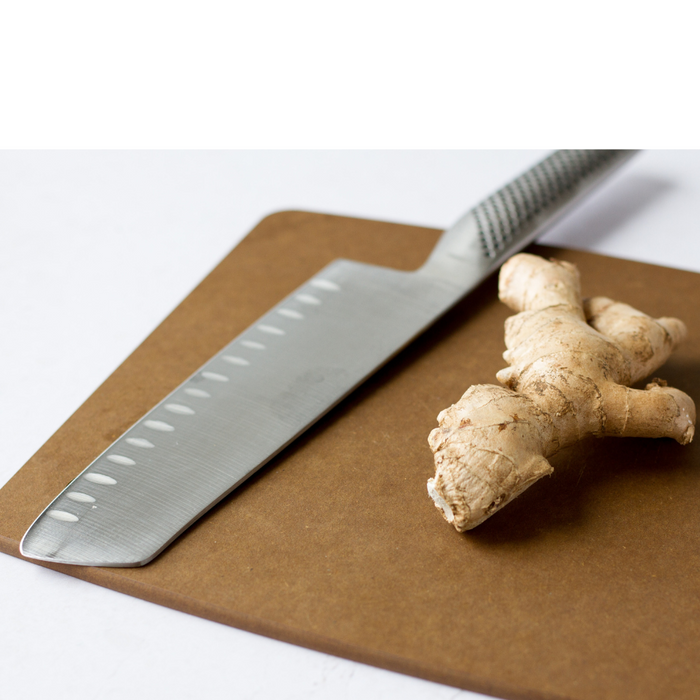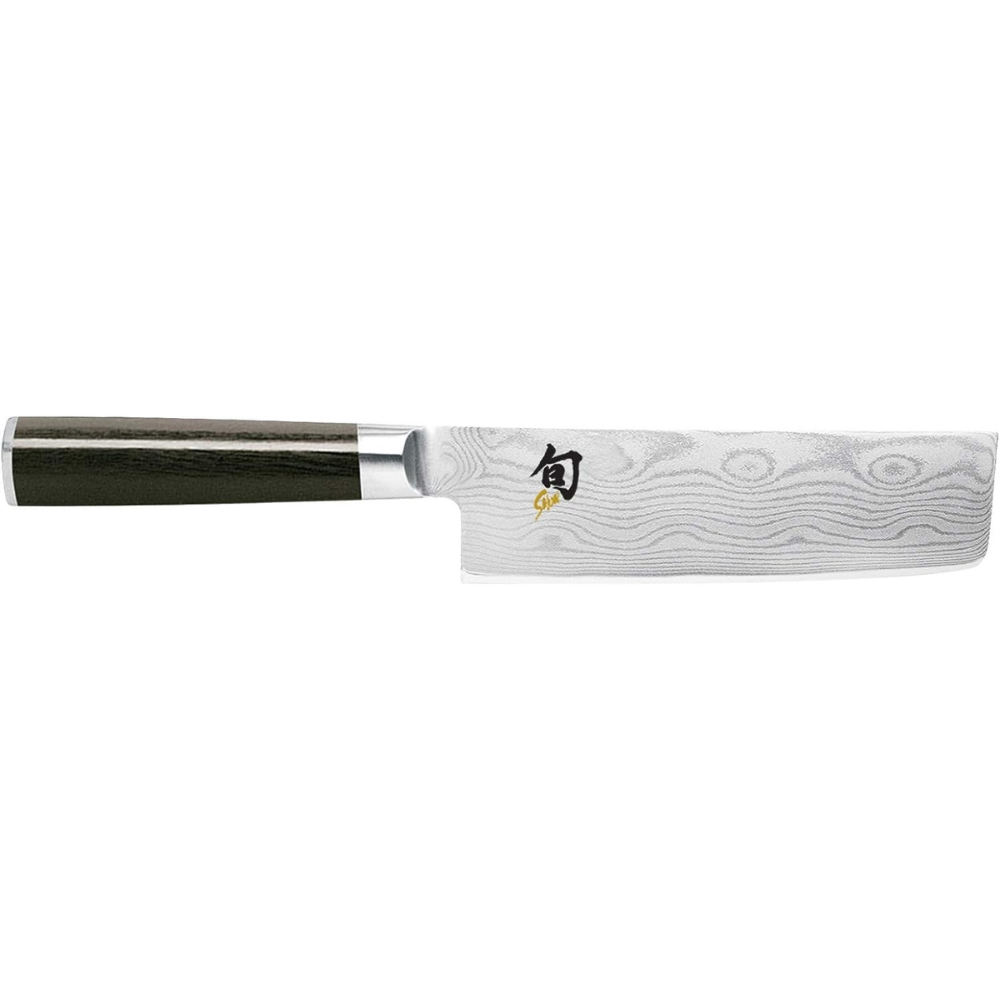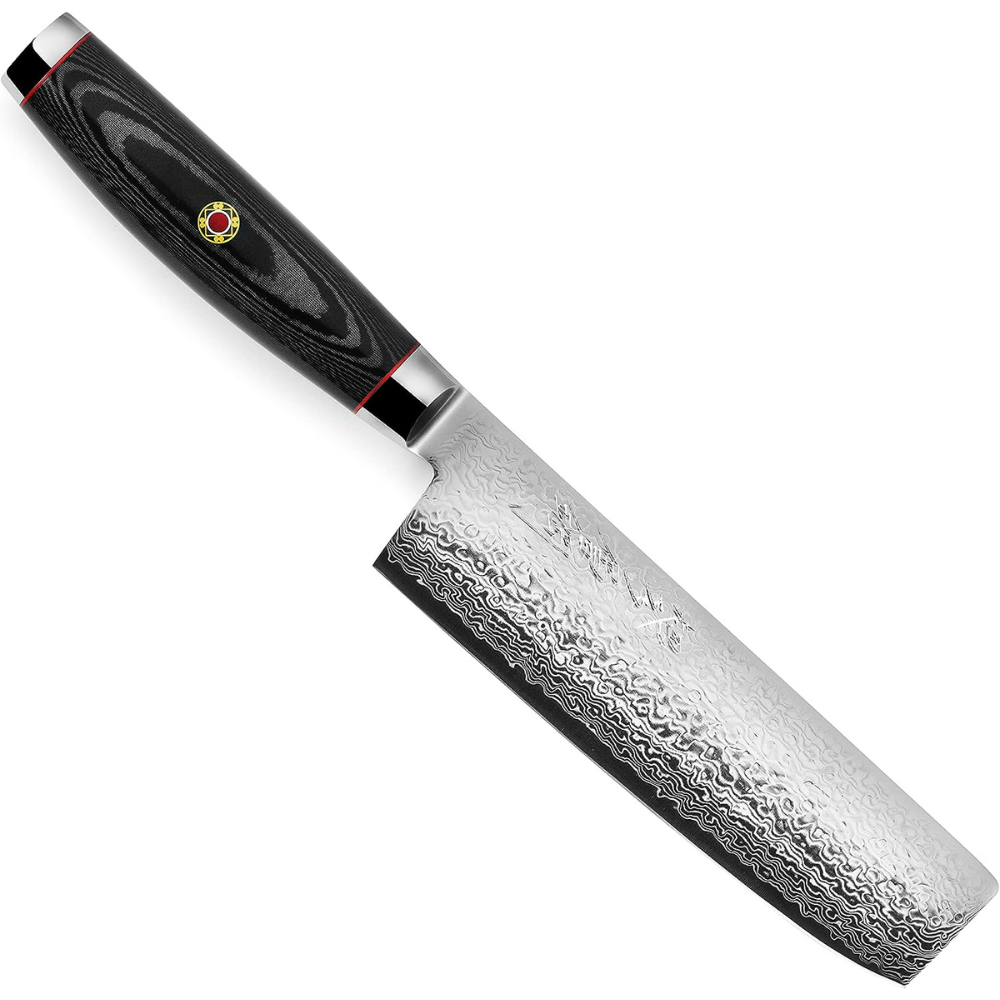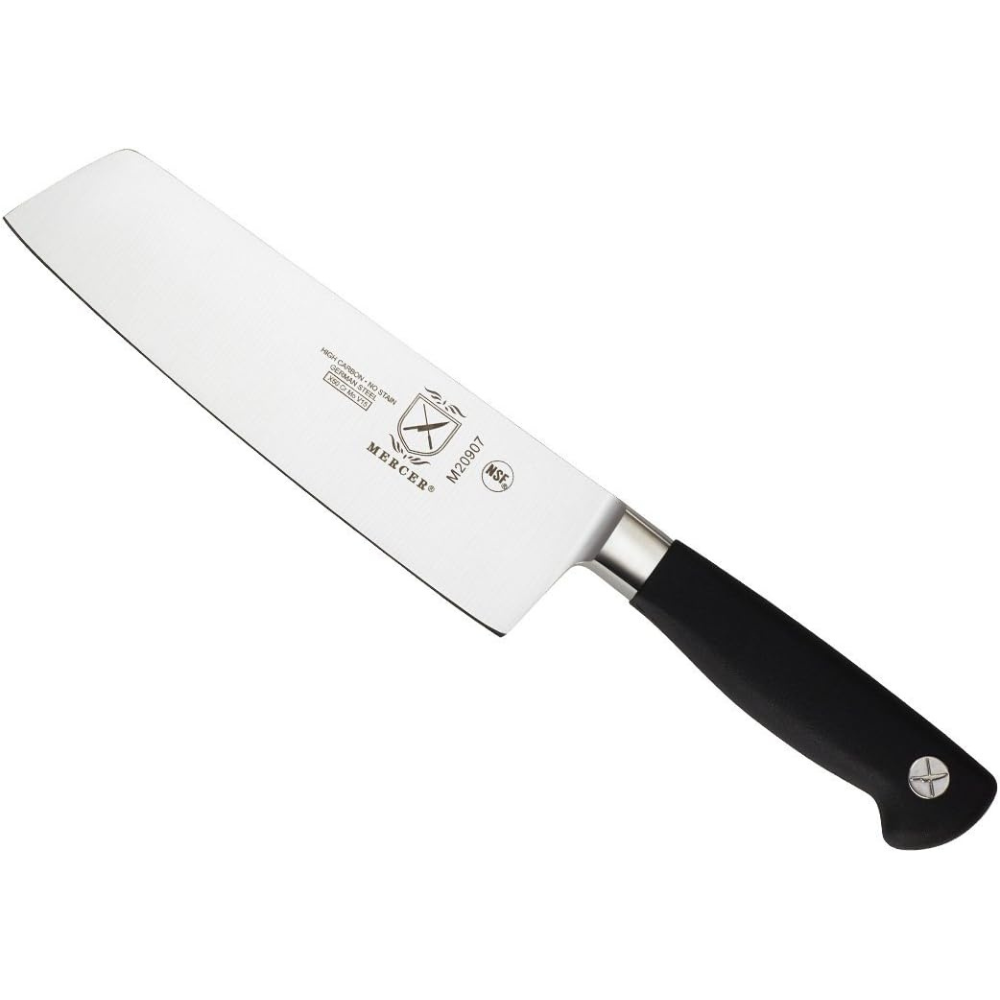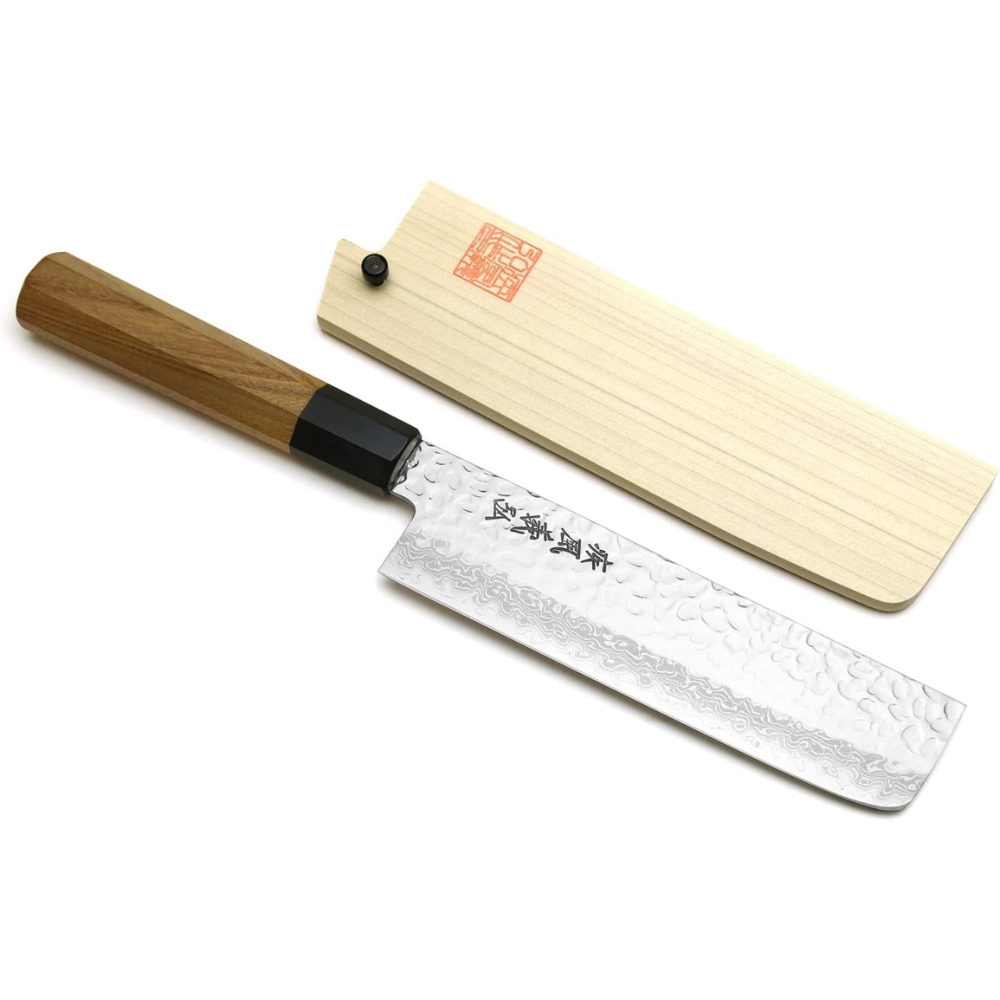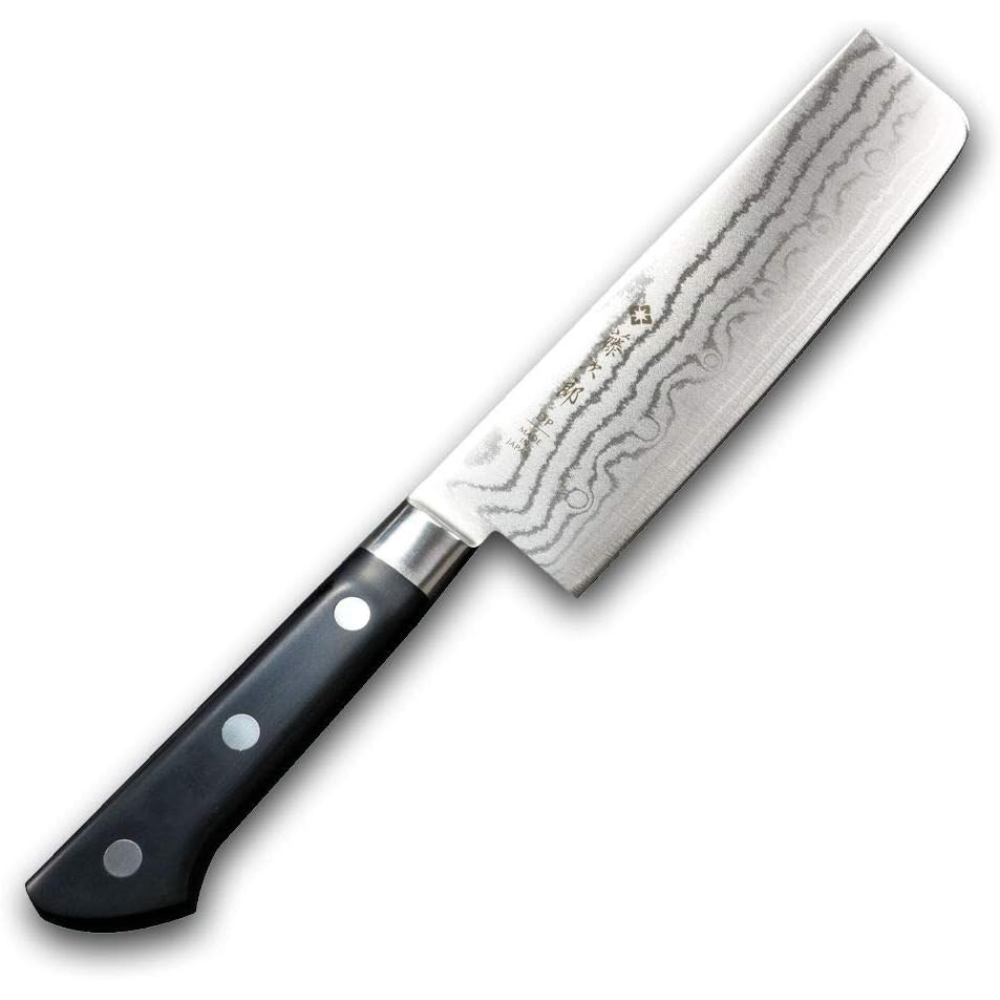If you're looking for the perfect kitchen knife to slice vegetables like a pro, or for a unique and beautiful gift, then look no further!
The Nakiri knife will be your new go-to choice for all of your vegetable-cutting needs.
With its wide flat blade and vertical cutting edge, you will use a Nakiri knife to make quick work of slicing and chopping almost any type of veggie without getting stuck in between slices.
The specialized Japanese blade style is ideal for cutting and chopping everything from delicate herbs to hearty root vegetables.
With their long, rectangular blades and sharp, straight blade, these Japanese vegetable knives are designed with precision edge technology to minimize veggie bruising.
The best Nakiri are high-carbon steel knives. They are typically made in Japan, forged using the layered Damascus method, and bear inscriptions, or "kanji", that describe the knife's characteristics, and how it was made.
The Nakiri knife may be smooth-finished, but most often is layered with an outer stainless steel finish that is hammered and polished.
The hammered finish on a Japanese vegetable knife, called "tsuchime", is traditionally done by hand. The pockets created by the hammering serve to prevent sliced food from sticking to the blade on a forged knife.
Stainless steel knives without the hammered finish will often bear hollow indentations in the blade to serve the same purpose.
A good Nakiri knife should have a sharp cutting edge, and be perfectly balanced, which makes it easy to use for extended periods without causing undue strain on your wrist and arm.
Whether you’re a home cook looking to expand your culinary collection or an experienced chef in need of precision tools, there is a Japanese Nakiri knife here for everyone!
Keep reading to learn more about our picks for some of the best Nakiri knives on the market.
Our process for finding the best Nakiri knife
There are so many Japanese knives on the market; who has time to read through all the features and Nakiri knife reviews?
Well, you are in luck! We have taken care of the research and compared knife features and thousands of reviews to bring you a list of Japanese knives that is sure to include the best Nakiri knife for you.
Included in our list is the best Nakiri knife if you are on a budget as well as the best Nakiri knife if you are in the mood to splurge. We also categorized the best related to the finish and composition of the knife.
Many are giftable, with beautiful presentation and packaging.
So, without further delay, here are our picks for the best Nakiri knives available in several categories.
No matter which you choose, you can't go wrong with a good Nakiri knife in your kitchen.
Shun Cutlery Classic Nakiri Knife
The Shun classic Nakiri knife is one of the highest-rated chef knives available today. Handcrafted in Seki City, Japan, it's made with a razor-sharp 16-degree double-beveled edge and a durable core of VG-MAX steel clad in 33 layers of Damascus stainless steel for maximum performance and minimal maintenance.
The Shun Nakiri is slightly heavier than other Japanese Nakiri knives, giving it a quality feel. The handcrafted ebony Pakka wood handle provides excellent balance and control while cutting.
This knife would make a beautiful gift and also comes with a lifetime warranty.
The Details:
6.5" full-tang blade, 7.5 ounces, 12" overall length
33 layers of Damascus stainless steel and VG MAX core for superior edge retention
16-degree double beveled edge
Protective sheath included
Pakka wood handle with D shape contour for excellent balance and control
Lifetime warranty
The Downside:
The knife handle is D-shaped for comfort, but applicable to right-handed users only.
Enso SG2 Nakiri Knife
The Enso is a beautiful Nakiri knife, handcrafted in Seki City, Japan with 101 layers of stainless Damascus steel.
Hand-engraved kanji on the blade reads Enso, meaning Harmony, and Hyaku Ichi Sō-kō, which means 101 Layer Steel.
The end cap of the handle reads Minori which means Harvest.
The Details:
7.6 ounces, 12" total length
Full tang, with 6.5" polished, corrosion-resistant blade
101 layer, Stainless Damascus Steel
12-degree double-beveled edge for right or left-handed use
The Downside:
Higher priced than other Nakiri knives
Global G-56, Classic Nakiri Knife
The Global G-56 Classic Nakiri knife is made in Japan, and the blade is stamped and molded from a single piece of stainless steel, making it more sanitary, corrosion resistant, and holds sharpness longer than other brands.
Dual-beveled for right or left-handed use. Well-balanced, and sturdy, this knife is high quality for the price, and is very positively reviewed by users!
The Details:
4.25 ounces, 7" hollowed blade, 11" total length
Molded stainless handle with divots for secure grip
Ice-tempered molybdenum/vanadium stainless steel is durable and corrosion resistant
12.5-degree double-beveled edge for right or left-handed use
The Downside:
An 11 inch Nakiri knife, the handle is smaller than others, and reported to be more comfortable for chefs with smaller hands.
Mercer Culinary Nakiri Knife
The Mercer company is a small business based out of New York. The Culinary Nakiri knife is made in Taiwan with German stainless steel which resists corrosion and holds its sharp edge.
This Japanese knife is designed for balance, control, and precision. It has consistently positive reviews despite it's lower price point.
The Details:
4 ounces, 7" stamped blade, 12" total length
Molded black "Santoprene" grip
High carbon stainless steel
15-degree double beveled edge for right or left-handed use
The Downside:
Customers say the plain cardboard packaging means this is not the best Nakiri knife for gifting.
Does not include a sheath, but you can buy one separately here on AMAZON
Yoshihiro VG-10 Nakiri Knife
The Yoshihiro VG-10 is one of the most popular knives available, famed for its robust construction and long-lasting sharpness. The knife is handcrafted in Japan from 46 layers of Damascus steel, which is polished and hammered to a beautiful finish. The knife's core is made from an alloy blend of V-Gold 10 (VG-10), Cobalt, Molybdenum, Vanadium and and high carbon steel. This allows the blade to hold a better edge than other types of steel.
The Details:
4.8 ounces, 6.5" hammered blade, 11.8" total length
Handcrafted ambrosia-wood handle
16-degree double beveled edge for right or left-handed use
Giftable presentation
The Downside:
Expensive compared to other similar Japanese knives on the market and the blade is on the shorter side. It does come with a protective sheath and a one-year warranty against defects.
Tojiro DP Damascus Nakiri Knife
Tojiro knives are renowned for their sharp blades. Their 7" Nakiri vegetable knife features 37 layers of Damascus steel, making it incredibly strong and durable.
The core of the blade material is made with VG-10 cobalt alloy steel, which gives it its razor-sharp edge and long-lasting performance. This knife combines both strength and precision in cutting vegetables.
The Details:
37-layered Damascus steel blade construction, 7" blade, 11.75" total length, 9.6 ounces
Knife features a full-tang micarta handle with a comfortable ergonomic shape
15-degree double beveled edge for right or left-handed use
Giftable presentation
The Downside:
It does not come with a protective sheath and the price is higher than other knives in its class. The blade may need to be sharpened more often than some others.
Tips for caring for your Nakiri knife
Your Nakiri knife is an essential tool for vegetable preparation, and its sharpness and precision are unmatched. However, taking good care of your Nakiri knife is crucial if you want it to last you a long time.
Since most Nakiri are carbon steel knives, they can be vulnerable to rust if not properly cared for.
Firstly, make sure to keep the blade on your Japanese knife dry at all times, immediately rinse or wash after using it and dry immediately.
Never wash your Nakiri knife in a dishwasher, hand wash only.
Using a honing steel every couple of uses is a great way to maintain the ideal edge. Also, storing your knife in a knife block or sheath will ensure safety and protect the blade from damage.
Always read and follow the manufacturer's instructions for your Nakiri knife. Remember, a well-cared-for knife is a happy knife!
It is also worth noting, due to its incredibly sharp blade edge, always use caution when cutting, and when you hand wash, and always use a cutting board!
A cutting glove, such as this one on AMAZON is recommended.
Keep out of the reach of small children and ensure older children are properly educated about knife safety, especially before using this razor-sharp blade.
Your Nakiri knife questions answered - FAQs
Why is a Nakiri knife good for vegetables?
a: A Nakiri knife has a straight blade with no pointed tip, allowing for clean and accurate slices. The blade on a Japanese knife is incredibly thin and sharp, which gives it the ability to make super thin slices of the toughest vegetables quickly and easily. This helps keep the vegetables looking their best while also preserving their flavor and texture in salads or stir-frys.
Nakiris are also great because they are very sharp knives, so you can use a Nakiri knife to cut through thick-skinned vegetables such as squash or eggplant without having to apply too much pressure on them, which can cause them to squish out of shape.
Nakiri knives are designed for maximum efficiency when it comes to slicing through tough veggies so you don't have to worry about wasting time or energy trying to hack away at something like butternut squash with another chef's knife that isn't suited for the job.
What sets Nakiris apart from traditional Western cooking knives is not just the design but also the materials used in blade construction. Traditional Nakiri knives are handcrafted from multiple layers of high-carbon stainless steel (or carbon steel), and are typically hammered by hand to create a texture that will prevent vegetables from sticking to the blade as you cut.
Using high-carbon steel ensures an extremely sharp edge as well as durability over many years of use—perfect for someone who loves preparing meals every day. When you invest in a quality tool, you want it to last for years.
And unlike some other types of knives, Nakiris won't corrode over time due to their high-quality building materials.
On top of all this goodness, Nakiri knife blade steel generally comes honed right out of the shop so they are ready to go right out of the boxwhen you purchase them. No need to spend hours learning how to sharpen and trying to get everything just right before use!
So whether you are looking for a more efficient way to chop up your vegetables or simply want a new tool that will add some fun to your daily kitchen activities; a Nakiri knife should be your number one choice!
Is a Nakiri knife only for vegetables?
a: No, the Nakiri knife is not only for vegetables. Many people mistakenly believe that this Japanese-style knife should be used exclusively for cutting vegetables, however, it's useful for a lot more!
The Nakiri knife is a double-beveled blade made from hard and durable carbon steel. It has a very thin edge, allowing it to easily cut through most types of food with ease. Its unique shape allows users to rock the blade back and forth for precise slicing - perfect for preparing sushi or julienning carrots!
The flat edge also helps ensure that delicate ingredients won't get crushed against the cutting board when making horizontal slices.
In addition to being highly versatile in food preparation, the Nakiri knife is also well suited to other applications in the kitchen such as dicing onions or slicing meats like chicken breast or steak.
Plus, its wide blade ensures minimal waste when chopping bell peppers and mushrooms – something you don’t always get with an ordinary chef's knife.
So while it may have originated as a vegetable cutter, the Nakiri's sharpness and excellent design make it one of the most multi-functional knives available on today's market!
What wouldn't you use a Nakiri or santoku for?
a: The Nakiri and Santoku knives are both great kitchen tools, but they have their limits! The Nakiri is a traditional Japanese vegetable knife with a thin yet sharp blade that can easily slice through even the toughest vegetables.
So what won't you use these two particular knives for? First off, neither of these blades is suitable for filleting or skinning fish because their short, wide blade length makes them difficult to manage when dealing with sensitive and slick surfaces.
You'll want to opt instead for a flexible fillet knife since its curved blade will give you more control over slicing delicate flesh easier than either of these blades could.
Furthermore, neither the Nakiri or Santoku knife should be used on hard ingredients such as nuts or frozen foods since their thin blades could become damaged in this process. If you are looking to crack open some walnuts or chop up an ice cream cake then you’ll need something like a cleaver that has enough weight behind it to chop through harder substances without getting damaged itself.
All-in-all though, the Nakiri and Santoku knife offer considerable functionality in terms of chopping vegetables and delicately slicing meats; just be sure not to overextend their uses when there are better alternatives available for tougher jobs!
Why are vegetable knives rectangular?
a: Japanese Nakiri knives are rectangular because of the slicing technique they are designed for. This type of Japanese knife has a rectangular blade, with a pointed tip and curved edges that make it easy to slice vegetables into thin, perfect slices with one smooth up and down motion.
The shape of the blade also helps reduce friction between the food and your cutting board as you slice.
Because there is less contact between the edge of the blade and your vegetables or fruit, this type of chef knife can help prevent bruising or tearing delicate ingredients like tomatoes or peppers.
Finally, vegetable knives tend to be shorter than other types of chef's knives which makes it easier to control when slicing foods into small cubes or julienne strips; so no need for hours at a time using stressful wrist motions trying to chop.
Vegetable knives create perfect cuts every time without stressing out your wrists!
How do you sharpen a Nakiri knife?
a: Sharpening a Japanese Nakiri knife is not overly complicated, but it does take some finesse and practice to get the job done properly.
First and foremost, you want to make sure that your vegetable knife is already well maintained and in good condition - if the blade material isn't in good condition, then sharpening won't do much for it!
Make sure you're starting out with a clean blade before attempting to sharpen it.
Once your knife is ready for sharpening, choose the right stone: an ultra-fine whetstone should work best for sharpening Nakiri knives.
Start sharpening at a low angle - somewhere between 10-15 degrees is optimal - using long strokes along the entire length of the blade.
Always keep a secure grip, but be careful not to press too hard as this can create uneven edges or even damage your blade over time!
As you progress through each side of the blade steel, gradually increase your angle up to 20 degrees max so you achieve an extra sharp edge without causing any ill effects.
Take care when honing both sides of your Nakiri knife's apex; this area needs an especially light touch as too much pressure can quickly chip away at its edges here more than other areas on the blade.
Finally, once you've finished honing each side of the knife be sure to (carefully) wipe off any excess debris from its surface and use a polishing cloth (such as microfiber) afterward to ensure that no burrs are left behind after sharpening.
Professional chefs will tell you, the best Japanese vegetable knife is a razor-sharp knife.
What does Nakiri mean in Japanese?
a: "Nakiri" (菜切り) is a Japanese term that is commonly said to mean "leaf cutter", although it literally translates to "vegetable cutter."
It’s a type of kitchen knife used for cutting vegetables and fruits into thin slices. The blade is usually rectangular, double-beveled, and may measure up to 8 inches in length.
These Japanese vegetable knives are quite popular as they can be used for slicing salads and other dishes with large amounts of vegetables or fruit.
The word Nakiri comes from two kanji characters: “na” meaning vegetable and "kiri" meaning cut or chop.
You may also hear it referred to as nai kasu ryōri bōchō which means kitchen-style chopper/divider knife, but this name doesn't typically appear on product labels or packaging for Nakiri knives.
Japanese Nakiri knives have been commonly used in Japan since at least the Edo period (1603–1867) with the first Nakiri knife appearing in cookbooks written during that period.
While its primary purpose is for dicing vegetables - such as preparing salads - some people find the Nakiri knife good for other tasks like chopping herbs; because of their unique shape, they can be very effective at mincing garlic and ginger too!
As with any well-crafted tool, ensuring your Nakiri knife stays sharp will increase its effectiveness significantly; regular honing with a whetstone or professional sharpening every few months should suffice to keep your blade at peak performance levels!
What is the best angle for a Nakiri knife edge?
a: The best angle for a Nakiri knife is typically 15 to 17 degrees.
This angle provides superior cutting and slicing capabilities, as well as greater durability and longevity than knives with higher angles, such as the traditional Japanese style of single-beveled knives which have an angle up to 30 degrees on one side with less material on the other side.
Because they are meant to cut using the least amount of force and a simple up-and-down motion, rather than push-cutting, a Nakiri vegetable knife should be sharpened regularly to maintain this ideal edge angle over time.
To get the most out of your Japanese Nakiri knife, you should use a whetstone or honing steel consistently to sharpen it after each use.
The most important thing when sharpening your Nakiri knife is consistency: make sure you do not deviate from the ideal 16-degree edge, since reducing that can easily ruin your blade if done incorrectly.
The material of your stone will also influence how quickly you can achieve and maintain that perfect 16-degree edge; stones made from harder materials allow for finer honing while softer stones may take longer but provide more consistent results in maintaining the desired angle over time.
It's also important to note that a properly sharpened Nakiri will cut through vegetables like butter due to its thin blade profile – thicker blades are better suited for chopping denser items like denser fruits and root vegetables – so aim for a razor’s edge at all times!
*It's worth mentioning here that some prefer even sharper edges below 15 degrees, but there's always risk involved when reducing angles too much – especially in regards to chipping or breaking blades entirely!
How long should a Nakiri knife be?
a: The size of a Nakiri knife depends on the intended use and the individual user's preference. Generally, these Japanese vegetable cleavers are around 6-7 inches in blade length, with an overall length of between 10-12 inches. While this is a common size, some blades can be longer or shorter depending on personal preference and the particular task at hand.
Nakiri knives usually have relatively thin blades compared to other types of kitchen knives since their primary purpose is slicing vegetables quickly and precisely. The thinness of the blade ensures that it glides effortlessly through vegetables without smashing them as thicker blades might do.
A larger Nakiri knife may be better suited for tackling tougher jobs such as breaking down large squash or melons, while smaller ones can navigate intricate tasks such as finely mincing herbs or preparing garnishes with ease.
When selecting a Nakiri knife for your kitchen, you should consider several factors beyond just its size: weight balance (including handle weight), tang type (one piece versus multiple pieces), handle material, construction material (stainless steel versus carbon steel), edge angle precision etc.
Ultimately though it will come down to how comfortable you are with the ergonomics and feel when using it. If you opt for something too small or too big it could lead to wrist fatigue during extended use so make sure you choose something that’s tailored to your needs!
So, which Nakiri knife is best for you?
We've talked about the best Nakiri knives on the market, and hopefully have answered all your questions so that you can find the perfect one to fit your cooking needs. Each has its features and characteristics that might appeal to you.
No matter which one you choose, make sure to take proper care of your Nakiri knives. Regular honing, cleaning, oiling and storage will help keep them cutting well for years to come!
Feel free to review our list and click the link below each to explore it further. You are sure to find the right Nakiri to add to your knife collection!

